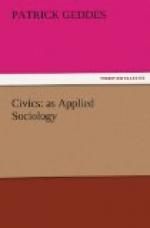more excellent concepts. But I fancy the general
idea of them all could be conveyed to the man in the
street under the covering of “the human shell.”
This shell of ours is the city. It is the protective
crust we have built round ourselves. In a smaller
sense our house is our shell, but in a larger sense
each house is only a lobe of the complex and contorted
whole. Geography shapes our shells from without,
and the spirit of our particular community shapes it
from within. History tells us how it has been
shaped in the past, Art tells us how it should be
shaped in the future. Professor Geddes, in fact,
envisages our civic shell as becomes a brilliant biologist,
who also happens to be a man of historic imagination,
ethical impulses, and aesthetic perceptions.
For the human shell is not merely geometrical and
architectural, like those of apian or beaverish communities;
it holds and expresses all those differences by which
we are exalted above the bee or the beaver. It
is coloured with our emotions and ideals, and contorted
with all the spirals of our history. And all these
manifestations of humanity may be studied as systematically
as those of the lower orders of creation, which have
till recently monopolised the privilege of pin and
label. The old lady who admired the benevolence
of Providence in always placing rivers by the side
of large towns was only expressing in an exaggerated
way the general failure to think of Civics scientifically.
The geographers, in whom may be found the bases of
the science, have always pointed out that the river
system is the essential unit for investigation.
From source to sea goes the line of evolution.
And yet even the peasant hamlet at the source depends,
as [Page: 144] Professor Geddes reminds us, on
the hinterland of pasture, forest, and chase; and
the hunter is the germ of the soldier and the aristocrat.
The whole region contributes to the ultimate city,
as the whole river to the ultimate sea. The Professor
says, justly enough, that we should try to recover
the elemental or naturalist point of view, even for
the greatest cities. He sees London as “fundamentally
an agglomeration of villages with their surviving
patches of common around a mediaeval seaport.”
This is accurate vision; but when he discerns “even
in the utmost magnificence of Paris, say, its Place
de l’Etoile, its spread of boulevards, but the
hunter’s tryst by the fallen tree, with its
radiating forest rides, each literally straight,”
I cannot help suspecting the over-ingenuity of a prolific
intellect. The view of London as a growth from
embryos, and the view of Paris as the outcome of atavistic
instinct, belong to different planes of scientific
thinking. That Haussmann in reconstructing Paris
was merely an unconscious hunter and woodlander, building
as automatically as a bee, is a fantastic hypothesis;
since cities, if they are to be built on a plan at
all, cannot avoid some unifying geometrical pattern;
and there are not very many possibilities....




